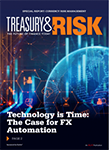 As corporate treasury executives forecast foreign exchange (FX) risks lurking on the horizon, they might consider what sci-fi author William Gibson noted about the future: It's already here, but unevenly distributed. Gibson's observation also applies to the growing adoption of FX risk management automation—some companies implemented this technology in the recent past, while others will do so soon—as well as to the technology's most valuable benefit: gaining more time for treasury staff to focus on other tasks.
As corporate treasury executives forecast foreign exchange (FX) risks lurking on the horizon, they might consider what sci-fi author William Gibson noted about the future: It's already here, but unevenly distributed. Gibson's observation also applies to the growing adoption of FX risk management automation—some companies implemented this technology in the recent past, while others will do so soon—as well as to the technology's most valuable benefit: gaining more time for treasury staff to focus on other tasks.
 Creating more bandwidth for that planning, analysis, and decision-making is becoming increasingly important as FX volatility intensifies, exposing companies to greater transaction risks and balance sheet risks, among other threats. "Most treasury functions have a good currency risk management structure," says Sankar Krishnan, executive vice president, banking and capital markets, for Capgemini. That said, Krishnan points to recent and "extreme fluctuations in currency prices" due to factors such as political events like Brexit, trade events such as tariffs, and even social media events. This instability, he adds, is "increasingly causing treasurers to step up their risk management like never before."
Creating more bandwidth for that planning, analysis, and decision-making is becoming increasingly important as FX volatility intensifies, exposing companies to greater transaction risks and balance sheet risks, among other threats. "Most treasury functions have a good currency risk management structure," says Sankar Krishnan, executive vice president, banking and capital markets, for Capgemini. That said, Krishnan points to recent and "extreme fluctuations in currency prices" due to factors such as political events like Brexit, trade events such as tariffs, and even social media events. This instability, he adds, is "increasingly causing treasurers to step up their risk management like never before."
Prashant Patri, a Deloitte risk and financial advisory principal in treasury, has witnessed treasury functions "enhancing their operating models, processes, and technology platforms that support FX risk management capabilities in recent years." These improvements, Patri continues, reflect a "rising awareness of FX risk and its increasingly visible impacts to financial statements."
Besides the gift of time, FX risk management automation can help treasury functions to lower costs, reduce compliance risks, and—most important—strengthen the management of FX exposures throughout the enterprise. Gage shares examples of companies that have used FX risk management automation to gain a more accurate understanding of their FX exposures, detect and correct shoddy accounting practices, significantly reduce exposures by adjusting currency-conversion activities, and lower overall FX risk by 40 percent or more.
Achieving these benefits requires an understanding of what elements of FX risk management these solutions support, obstacles to avoid, and three drivers of successful implementations.
From Pre-Trade Through Post-Trade
FX risk management automation is designed to help treasurers gain a more precise and timely view of the company's total FX exposure. "Historically, firms have lacked visibility into FX exposures across the organization, particularly cash flow forecasts and stress results by transaction currency," notes Lisa Maus, a principal with EY's financial services organization. "As such, firms lacked the ability to proactively identify structural currency mismatches that could arise in both business-as-usual and during stress."
A decade or so ago, this visibility problem vexed many treasury functions. The opacity stemmed from the fact that most, if not all, of the pretrade components of FX risk management consisted of manual processes that were tracked and monitored via spreadsheets. FX exposures were determined by pulling together spreadsheets from various businesses and then aggregating and analyzing that data, much of which originated in enterprise resource planning (ERP) systems and other finance and accounting applications.
This approach often raised troubling questions, Gage notes, such as 'Do we have all the data we need?' and 'Is the data we have accurate?' "Once they retrieved all of that information, treasury people were not confident that they had the right data," he says. Analyses of inaccurate data could distort actual FX gains and losses.
FX risk management automation consists of technology tools and platforms that reduce or eliminate manual interventions throughout the end-to-end FX risk management lifecycle. "There are various tools and platforms available to potentially automate the entire currency risk management lifecycle," Patri explains. "The most common components of currency risk management programs that can be automated are the upstream exposure aggregation, netting, and analytics processes and downstream transaction execution processes," which include execution, confirmation, and settlement.
Gage and Krishnan offer similar definitions that center on the automation of most pre-trade processes (e.g., exposure analysis andthe automation of workflows) and post-trade activities (accounting for a trade in treasury management systems and accounting applications). "To me, FX risk management automation is having a set of automatic responses to any movement in FX rates—and this is in both directions of an FX trade," Krishnan notes. "Automated systems should predict FX risk ahead of the risk itself, and with predictive analytics, managing FX risks and outcomes becomes a lot easier."
Krishnan lists five functions these applications support: identifying FX exposures; recommending risk-mitigation strategies (e.g., hedging approaches); creating seamless integration to the treasurer's preferred bank(s); equipping treasury functions with insights on how to minimize hedging costs; and leveraging advanced technologies—including application programming interfaces (APIs), robotic process automation (RPA), and machine learning—to better manage the end-to-end currency risk management process and strengthen decision-making.
Deloitte's Patri agrees, noting that RPA, predictive analytics, and other advanced technologies are currently driving the evolution of FX risk management automation solutions by helping treasury functions more effectively aggregate, analyze, and predict FX exposures. "Greater vendor investment in the FX technology space," he adds, "is driving more end-to-end automation."
Triggers and Benefits
The adoption of FX risk management automation by treasury functions can be triggered by a range of factors, including:
- The lack of a currency risk management program. "We've seen companies realize that they need to build an FX management program after enduring a few difficult quarters," Gage reports.
- FX losses. In other cases, companies with currency risk management capabilities already in place may consider automation after enduring FX losses or after determining that their current capabilities require improvements.
- An acquisition. The need to quickly and easily integrate a newly purchased company's FX exposures into the acquiring company's FX risk management program also may drive investment in new supporting technology.
- Difficulties managing FX volatility. Gage estimates that roughly 30 percent of Kyriba's current customers made the investment in FX risk management automation to more effectively manage periods of high FX volatility.
These developments often drive treasury decision-makers to take a closer look at the benefits of FX risk management automation, which extend beyond an improved ability to mitigate the effects of volatility. "FX risk management automation can really help lower the risk of errors caused by manual intervention," Patri says. "Automation also offers an improved ability to run analytics and reporting, as well as improve process efficiency throughout the end-to-end FX risk lifecycle."
Gage agrees, noting that using spreadsheets to manage hedging programs with high volumes of transactions creates "numerous potential points of failure, opening up major compliance risks." He also points to cost-reduction benefits. "Once a company is comfortable that they've improved their ability to manage FX risk, they tend to look for new ways to reduce costs," says Gage, noting that these approaches may include leveraging better analyses that can help them eliminate the need to hedge by mitigating risks through other means.
To be sure, FX risk management improvements are almost always the key return treasury functions seek when investing in this type of automation. "The first question in any business case is: Can we improve our ability to manage FX risk?" Gage says. "That doesn't necessarily mean they're going to lower the risk. They may find they are comfortable taking on a risk when they can manage it, and related expectations, with much more certainty. That can be a huge benefit."

Three Enablers of Implementation Success
As is the case with other forms of treasury and enterprise technology systems, the implementation of FX risk management automation demands an understanding of business requirements, the selection of a solution based on those requirements, and knowledge of the vendor's future plans for its solution. The selection decision is typically followed by solution design, configuration, and several rounds of testing before the data migration takes place and the application comes online.
FX risk management automation implementations also pose some unique challenges. Implementing bank connectivity for transaction settlements may be a time-consuming part of the process for treasury functions that work with a high number of banking partners, notes Patri, who stresses that it is important to get the implementation right through rigorous technology project management. "Missed requirements, incorrect development, and insufficient testing can all prove incredibly tough to remedy during or after an FX risk management automation solution is implemented," he notes. Capgemini's Krishnan points out that legacy systems with insufficient workflow management, IT development strategies that are ineffective, and a lack of knowledge about FX risk and hedging inside the treasury function also can pose implementation obstacles.
The following activities and mechanisms can help treasury teams sidestep—or at least reduce the negative impacts of—those issues:
- Cross-functional alignment. The treasury function, several finance function groups, and the IT function usually share custodianship of the data that FX risk management applications need to determine exposures and generate related analysis and insights. As a result, those groups need to be aligned on how that data is accessed, managed, secured, and shared, according to Gage, who emphasizes the value of organizational alignment around FX data management.
- FX risk management maturity. Inside the treasury function, decision-makers should have a strong grasp of their company's risk appetite and how it influences their approach to FX risk. Having well-defined FX risk management policies and procedures "can help guide decision-making around operating models, processes, and technology platforms," says Patri, who also notes that it is important for non-treasury leaders throughout the organization to have a strong grasp of FX risk management. "It is important for treasury teams to serve as catalysts and further educate other groups within companies about the importance of FX risk management," Patri asserts. Gage views the enterprise risk committee that many midsize to large companies operate as an ideal forum in which treasury leaders can "continually drive currency management awareness while highlighting opportunities for adopting best practices" related to FX risk management.
- Rigorous IT project management. Patri recommends that companies dedicate project management resources as well as IT resources to help treasury managers plan and conduct the implementation of FX risk management automation. He notes that IT experts are especially valuable during the interface development and testing phases of the deployment.
Gage agrees with this recommendation. "I think it's very important to have strong internal project management available," he says. "Somebody from the IT side who is a strong program manager can help work through these things in a very methodical way. That can make all the difference when a deployment is complex."
This type of project-specific and longer-term collaboration among treasury leaders and their counterparts in other segments of the business can also help lay the groundwork for a sharp increase in the risk-focused consultative work that treasury executives conduct following the implementation of an FX risk management automation. That gets to a final benefit the technology can deliver—one that relates to time on a more personal level.
"I've seen it happen in a number of different companies: Members of the treasury team become much stronger internal consultants who work closely with the business units to help them understand how their activities shape FX exposure," Gage says. "The insights they gain from this technology tend to be highly appreciated throughout the organization."
 Also from the October 2019 Special Report:
Also from the October 2019 Special Report:
- Sponsored Statement—Kyriba: "Managing Foreign Exchange Amidst Continued Geopolitical Uncertainty"
- View the October 2019 Digital Edition here
Eric Krell's work has appeared previously in Treasury & Risk, as well as Consulting Magazine. He is based in Austin, TX.
© 2025 ALM Global, LLC, All Rights Reserved. Request academic re-use from www.copyright.com. All other uses, submit a request to [email protected]. For more information visit Asset & Logo Licensing.





